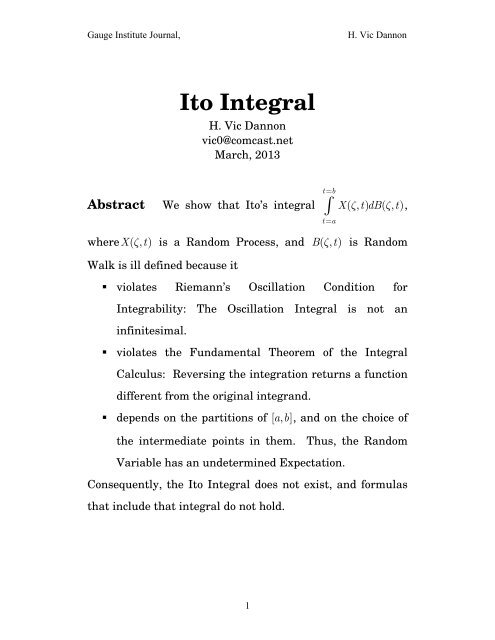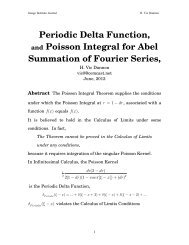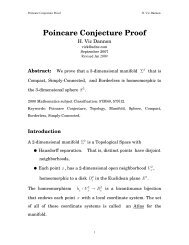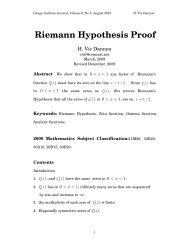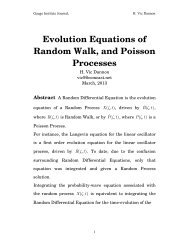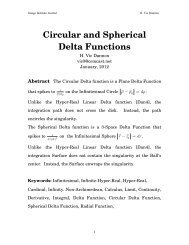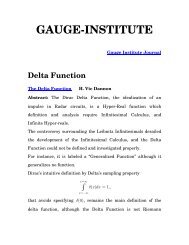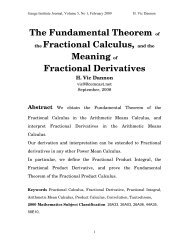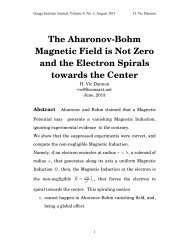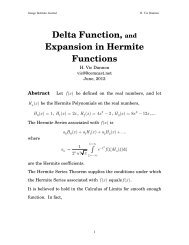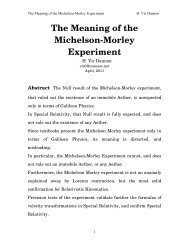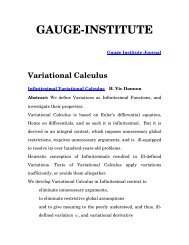Ito Integral - Gauge-institute.org
Ito Integral - Gauge-institute.org
Ito Integral - Gauge-institute.org
Create successful ePaper yourself
Turn your PDF publications into a flip-book with our unique Google optimized e-Paper software.
<strong>Gauge</strong> Institute Journal,<br />
H. Vic Dannon<br />
<strong>Ito</strong> <strong>Integral</strong><br />
H. Vic Dannon<br />
vic0@comcast.net<br />
March, 2013<br />
t=<br />
b<br />
Abstract We show that <strong>Ito</strong>’s integral X(,) ζ t dB(,)<br />
ζ t ,<br />
∫<br />
t=<br />
a<br />
where X(,)<br />
ζ t is a Random Process, and B(,)<br />
ζ t is Random<br />
Walk is ill defined because it<br />
• violates Riemann’s Oscillation Condition for<br />
Integrability: The Oscillation <strong>Integral</strong> is not an<br />
infinitesimal.<br />
• violates the Fundamental Theorem of the <strong>Integral</strong><br />
Calculus: Reversing the integration returns a function<br />
different from the original integrand.<br />
• depends on the partitions of [ ab] , , and on the choice of<br />
the intermediate points in them. Thus, the Random<br />
Variable has an undetermined Expectation.<br />
Consequently, the <strong>Ito</strong> <strong>Integral</strong> does not exist, and formulas<br />
that include that integral do not hold.<br />
1
<strong>Gauge</strong> Institute Journal,<br />
H. Vic Dannon<br />
Keywords: <strong>Ito</strong> <strong>Integral</strong>, <strong>Ito</strong> Process, <strong>Ito</strong> Formula, Stochastic<br />
Integration, Infinitesimal, Infinite-Hyper-real, Hyper-real,<br />
Calculus, Limit, Continuity, Derivative, <strong>Integral</strong>, Delta<br />
Function, Random Variable, Random Process, Random<br />
Signal, Stochastic Process, Stochastic Calculus, Probability<br />
Distribution, Bernoulli Random Variables, Binomial<br />
Distribution, Gaussian, Normal, Expectation, Variance,<br />
Random Walk, Poisson Process,<br />
2000 Mathematics Subject Classification 26E35; 26E30;<br />
26E15; 26E20; 26A06; 26A12; 03E10; 03E55; 03E17; 03H15;<br />
46S20; 97I40; 97I30.<br />
2
<strong>Gauge</strong> Institute Journal,<br />
H. Vic Dannon<br />
Contents<br />
Introduction<br />
1. Hyper-real Line<br />
2. Hyper-real Function<br />
3. <strong>Integral</strong> of a Hyper-real Function<br />
4. Delta Function<br />
5. Random Walk B(,)<br />
ζ t<br />
6. Integration sums of B(,)<br />
ζ t with respect to B(,)<br />
ζ t .<br />
t=<br />
b<br />
∑<br />
7. B(,) ζ t dB(,)<br />
ζ t is ill-defined.<br />
t=<br />
a<br />
t=<br />
b<br />
∑<br />
8. B(,) ζ t dB(,)<br />
ζ t depends on the choice of the<br />
t=<br />
a<br />
intermediate points in the partition of [ B(<br />
ζ, a), B( ζ, b)]<br />
9. The Myth that Lebesgue <strong>Integral</strong> generalizes Riemann’s<br />
t=<br />
b<br />
∑<br />
10. B(,) ζ t dB(,)<br />
ζ t violates the Fundamental Theorem of<br />
t=<br />
a<br />
the <strong>Integral</strong> Calculus.<br />
11. <strong>Ito</strong>’s Process and <strong>Ito</strong>’s Formula<br />
References<br />
3
<strong>Gauge</strong> Institute Journal,<br />
H. Vic Dannon<br />
Introduction<br />
In [Dan5], we defined in Infinitesimal Calculus the Wiener<br />
t=<br />
b<br />
<strong>Integral</strong> ∫ f () tdB(, ζ t)<br />
, where f () t is integrable hyper-real<br />
t=<br />
a<br />
function, and<br />
B(,)<br />
ζ t<br />
is a Random Walk.<br />
In [<strong>Ito</strong>], <strong>Ito</strong> argued that f () t can be replaced with a Hyperreal<br />
Random Process X(,)<br />
ζ t .<br />
We argue here that his claim fails for X(,) ζ t = B(,)<br />
ζ t .<br />
We show that <strong>Ito</strong>’s approach through Lebesgue Integration,<br />
ignores the basics of Integration set by Riemann.<br />
The <strong>Ito</strong> integration sums do not converge to an <strong>Integral</strong>.<br />
The <strong>Ito</strong> integral<br />
t=<br />
b<br />
∫<br />
t=<br />
a<br />
B(,) ζ t dB(,)<br />
ζ t<br />
is ill defined because it<br />
• violates Riemann’s Oscillation Condition for<br />
Integrability: The Oscillation <strong>Integral</strong> is not an<br />
infinitesimal.<br />
• violates the Fundamental Theorem of the <strong>Integral</strong><br />
Calculus: Reversing the integration returns a function<br />
different from the original integrand.<br />
4
<strong>Gauge</strong> Institute Journal,<br />
H. Vic Dannon<br />
• depends on the partitions of [ ab] , , and on the choice of<br />
the intermediate points in them. Thus, the Random<br />
Variable has an undetermined Expectation.<br />
Any integration is an infinite summation. Then, we cannot<br />
tell the difference between<br />
t=<br />
b<br />
t=<br />
b<br />
∑ X(,)[ ζ t X(, ζ t + dt) −X(,)]<br />
ζ t ,<br />
t=<br />
a<br />
∑ X(, ζ t + dt)[ X(, ζ t + dt) −X(,)]<br />
ζ t ,<br />
t=<br />
a<br />
and any summation in between them<br />
t=<br />
b<br />
∑<br />
t=<br />
a<br />
⎡λX(,) ζ t (1 λ) X(, ζ t dt)[ ⎤<br />
⎣<br />
+ − +<br />
⎦<br />
X(, ζ t + dt) −X(,)]<br />
ζ t<br />
It is not up to us to choose the sum with<br />
1<br />
λ = , and it is<br />
2<br />
meaningless to say that we did that.<br />
The infinite summation yields a definite value, only if all<br />
these –impossible to distinguish between- results, are all the<br />
same.<br />
Furthermore, when we encounter uncertain outcomes, our<br />
first measure of certainty is the average. The average is<br />
what we expect, give or take some deviation.<br />
5
<strong>Gauge</strong> Institute Journal,<br />
H. Vic Dannon<br />
Thus, our first measure is the Expectation of the Random<br />
Variable, and our second measure is the Variance, which<br />
over time will limit the Expectation within a band.<br />
If we cannot tell the Average of our outcomes, our Random<br />
Variable is undefined, and should be discarded.<br />
Thus, a Random Process<br />
X(,)<br />
ζ t<br />
may not be integrated with<br />
respect to a Random Walk<br />
B(,)<br />
ζ t , and an <strong>Integral</strong> in which<br />
f () t is replaced by<br />
X(,)<br />
ζ t<br />
does not exist.<br />
6
<strong>Gauge</strong> Institute Journal,<br />
H. Vic Dannon<br />
1.<br />
Hyper-real Line<br />
The minimal domain and range, needed for the definition<br />
and analysis of a hyper-real function, is the hyper-real line.<br />
Each real number α can be represented by a Cauchy<br />
sequence of rational numbers, ( r , r , r ,...) so that r → α .<br />
1 2 3<br />
The constant sequence ( ααα , , ,...) is a constant hyper-real.<br />
In [Dan2] we established that,<br />
1. Any totally ordered set of positive, monotonically<br />
n<br />
decreasing to zero sequences<br />
family of infinitesimal hyper-reals.<br />
( ι1, ι2, ι3,...)<br />
constitutes a<br />
2. The infinitesimals are smaller than any real number,<br />
yet strictly greater than zero.<br />
1 1 1<br />
3. Their reciprocals ( , , ,...<br />
ι 1<br />
ι 2<br />
ι 3<br />
) are the infinite hyperreals.<br />
4. The infinite hyper-reals are greater than any real<br />
number, yet strictly smaller than infinity.<br />
7
<strong>Gauge</strong> Institute Journal,<br />
H. Vic Dannon<br />
5. The infinite hyper-reals with negative signs are<br />
smaller than any real number, yet strictly greater than<br />
−∞.<br />
6. The sum of a real number with an infinitesimal is a<br />
non-constant hyper-real.<br />
7. The Hyper-reals are the totality of constant hyperreals,<br />
a family of infinitesimals, a family of<br />
infinitesimals with negative sign, a family of infinite<br />
hyper-reals, a family of infinite hyper-reals with<br />
negative sign, and non-constant hyper-reals.<br />
8. The hyper-reals are totally ordered, and aligned along<br />
a line: the Hyper-real Line.<br />
9. That line includes the real numbers separated by the<br />
non-constant hyper-reals. Each real number is the<br />
center of an interval of hyper-reals, that includes no<br />
other real number.<br />
10. In particular, zero is separated from any positive<br />
real by the infinitesimals, and from any negative real<br />
by the infinitesimals with negative signs, −dx .<br />
11. Zero is not an infinitesimal, because zero is not<br />
strictly greater than zero.<br />
8
<strong>Gauge</strong> Institute Journal,<br />
H. Vic Dannon<br />
12. We do not add infinity to the hyper-real line.<br />
13. The infinitesimals, the infinitesimals with<br />
negative signs, the infinite hyper-reals, and the infinite<br />
hyper-reals with negative signs are semi-groups with<br />
respect to addition. Neither set includes zero.<br />
∞<br />
14. The hyper-real line is embedded in , and is<br />
not homeomorphic to the real line. There is no bicontinuous<br />
one-one mapping from the hyper-real onto<br />
the real line.<br />
15. In particular, there are no points on the real line<br />
that can be assigned uniquely to the infinitesimal<br />
hyper-reals, or to the infinite hyper-reals, or to the nonconstant<br />
hyper-reals.<br />
16. No neighbourhood of a hyper-real is<br />
n<br />
homeomorphic to an ball. Therefore, the hyperreal<br />
line is not a manifold.<br />
17. The hyper-real line is totally ordered like a line,<br />
but it is not spanned by one element, and it is not onedimensional.<br />
9
<strong>Gauge</strong> Institute Journal,<br />
H. Vic Dannon<br />
2.<br />
Hyper-real Function<br />
2.1 Definition of a hyper-real function<br />
f () x is a hyper-real function, iff it is from the hyper-reals<br />
into the hyper-reals.<br />
This means that any number in the domain, or in the range<br />
of a hyper-real f () x is either one of the following<br />
real<br />
real + infinitesimal<br />
real – infinitesimal<br />
infinitesimal<br />
infinitesimal with negative sign<br />
infinite hyper-real<br />
infinite hyper-real with negative sign<br />
Clearly,<br />
2.2 Every function from the reals into the reals is a hyperreal<br />
function.<br />
10
<strong>Gauge</strong> Institute Journal,<br />
H. Vic Dannon<br />
3.<br />
<strong>Integral</strong> of Hyper-real Function<br />
In [Dan3], we defined the integral of a Hyper-real Function.<br />
Let f () x be a hyper-real function on the interval [ ab] , .<br />
The interval may not be bounded.<br />
f () x may take infinite hyper-real values, and need not be<br />
bounded.<br />
At each<br />
a<br />
≤<br />
x<br />
≤b,<br />
there is a rectangle with base<br />
dx<br />
[ x − , x + 2<br />
], height f () x ,<br />
dx<br />
2<br />
and area<br />
f ( xdx. )<br />
We form the Integration Sum of all the areas for the x ’s<br />
that start at x = a, and end at x = b,<br />
∑ f ( xdx ) .<br />
x∈[ a, b]<br />
If for any infinitesimal dx , the Integration Sum has the<br />
same hyper-real value, then f () x is integrable over the<br />
interval [ ab] , .<br />
11
<strong>Gauge</strong> Institute Journal,<br />
H. Vic Dannon<br />
Then, we call the Integration Sum the integral of f () x from<br />
x = a, to x = b, and denote it by<br />
x=<br />
b<br />
∫ f ( xdx ) .<br />
x=<br />
a<br />
If the hyper-real is infinite, then it is the integral over [, ab] ,<br />
If the hyper-real is finite,<br />
x=<br />
b<br />
∫ fxdx ( ) = real part of the hyper-real . <br />
x=<br />
a<br />
3.1 The countability of the Integration Sum<br />
In [Dan1], we established the equality of all positive<br />
infinities:<br />
We proved that the number of the Natural Numbers,<br />
Card , equals the number of Real Numbers,<br />
2 Card <br />
Card = , and we have<br />
2 Card<br />
2<br />
Card <br />
Card = ( Card) = .... = 2 = 2 = ... ≡ ∞.<br />
In particular, we demonstrated that the real numbers may<br />
be well-ordered.<br />
12
<strong>Gauge</strong> Institute Journal,<br />
H. Vic Dannon<br />
Consequently, there are countably many real numbers in the<br />
interval<br />
[,] ab<br />
, and the Integration Sum has countably many<br />
terms.<br />
While we do not sequence the real numbers in the interval,<br />
the summation takes place over countably many f ( xdx. )<br />
The Lower <strong>Integral</strong> is the Integration Sum where f ( x ) is<br />
replaced<br />
by its lowest value on each interval<br />
3.2<br />
∑<br />
x∈[ a, b]<br />
⎛<br />
⎜⎝<br />
dx dx<br />
2 2<br />
[ x − , x + ]<br />
⎞<br />
inf f ( t)<br />
dx<br />
⎠⎟<br />
x− ≤t≤ x+<br />
dx dx<br />
2 2<br />
The Upper <strong>Integral</strong> is the Integration Sum where f ( x ) is<br />
replaced by its largest value on each interval<br />
3.3<br />
∑<br />
x∈[ a, b]<br />
⎛<br />
⎜⎝<br />
⎞ sup f ( t)<br />
dx<br />
⎠⎟<br />
dx dx<br />
2 2<br />
x− ≤t≤ x+<br />
[ x − , x + ]<br />
dx dx<br />
2 2<br />
If the integral is a finite hyper-real, we have<br />
13
<strong>Gauge</strong> Institute Journal,<br />
H. Vic Dannon<br />
3.4 A hyper-real function has a finite integral if and only if<br />
its upper integral and its lower integral are finite, and differ<br />
by an infinitesimal.<br />
14
<strong>Gauge</strong> Institute Journal,<br />
H. Vic Dannon<br />
4.<br />
Delta Function<br />
In [Dan4], we defined the Delta Function, and established its<br />
properties<br />
1. The Delta Function is a hyper-real function defined<br />
from the hyper-real line into the set of two hyper-reals<br />
⎧<br />
⎪ 1 ⎫<br />
⎨0, ⎪<br />
⎬. The hyper-real 0 is the sequence 0, 0, 0,... .<br />
⎪⎩<br />
dx<br />
⎭⎪ The infinite hyper-real 1<br />
dx<br />
depends on our choice of<br />
dx .<br />
2. We will usually choose the family of infinitesimals that<br />
is spanned by the sequences<br />
1<br />
n , 1<br />
2<br />
n<br />
,<br />
1<br />
n<br />
3<br />
,… It is a<br />
semigroup with respect to vector addition, and includes<br />
all the scalar multiples of the generating sequences<br />
that are non-zero. That is, the family includes<br />
infinitesimals with negative sign. Therefore,<br />
1<br />
dx<br />
will<br />
mean the sequence n . Alternatively, we may choose<br />
15
<strong>Gauge</strong> Institute Journal,<br />
H. Vic Dannon<br />
the family spanned by the sequences<br />
1<br />
2 n ,<br />
1<br />
3 n ,<br />
1<br />
4 n ,… Then, 1<br />
dx<br />
will mean the sequence<br />
2 n . Once we determined the basic infinitesimal dx ,<br />
we will use it in the Infinite Riemann Sum that defines<br />
an <strong>Integral</strong> in Infinitesimal Calculus.<br />
3. The Delta Function is strictly smaller than ∞<br />
4. We define,<br />
1<br />
χ δ ( x) ≡ dx ( )<br />
,<br />
dx x<br />
dx<br />
⎡ ⎤ ,<br />
⎢−<br />
⎣ 2 2 ⎥⎦<br />
where<br />
χ ⎡<br />
⎢−<br />
⎣<br />
dx,<br />
dx<br />
2 2<br />
⎧ dx dx<br />
1, x ∈ ⎡−<br />
, ⎤<br />
( x)<br />
= ⎪ ⎢ 2 2 ⎥<br />
⎨ ⎣ ⎦ .<br />
⎪⎪ 0, otherwise<br />
⎩<br />
⎤<br />
⎥⎦<br />
5. Hence,<br />
for x < 0 , δ ( x) = 0<br />
at<br />
for<br />
dx<br />
x =− , δ( x)<br />
jumps from 0 to<br />
2<br />
dx dx<br />
⎢ ⎣<br />
,<br />
2 2 ⎥ ⎦ , 1<br />
( x)<br />
x ∈ ⎡−<br />
⎤<br />
δ = .<br />
dx<br />
1<br />
dx ,<br />
at x = 0 ,<br />
δ (0) =<br />
1<br />
dx<br />
at<br />
dx<br />
x = , δ( x)<br />
drops from<br />
2<br />
for x > 0 , δ ( x) = 0.<br />
1<br />
dx<br />
to 0.<br />
16
<strong>Gauge</strong> Institute Journal,<br />
H. Vic Dannon<br />
xδ ( x) = 0<br />
6. If dx =<br />
1<br />
, ( x) = 1 1( x),2 1 1( x),3 1 1( x )...<br />
n<br />
[ − , ] [ − , ] [ − , ]<br />
δ χ χ χ<br />
2 2 4 4 6 6<br />
7. If dx =<br />
2<br />
,<br />
n<br />
8. If dx =<br />
1<br />
,<br />
n<br />
1 2 3<br />
δ ( x) = , , ,...<br />
2 2 2<br />
2 cosh x 2 cosh 2x 2 cosh 3x<br />
−x −2x −3x<br />
[0, ∞) [0, ∞) [0, ∞)<br />
δ( x) = e χ ,2 e χ , 3 e χ ,...<br />
x =∞<br />
∫<br />
9. δ( xdx ) = 1.<br />
x =−∞<br />
k =∞<br />
1 −ik( ξ−x<br />
)<br />
10. δξ ( − x)<br />
= e<br />
2π<br />
∫ dk<br />
k =−∞<br />
17
<strong>Gauge</strong> Institute Journal,<br />
H. Vic Dannon<br />
5.<br />
Random Walk B(,)<br />
ζ t<br />
The Random Walk of small particles in fluid is named after<br />
Brown, who first observed it, Brownian Motion. It models<br />
other processes, such as the fluctuations of a stock price.<br />
In a volume of fluid, the path of a particle is in any direction<br />
in the volume, and of variable size<br />
5.1 Bernoulli Random Variables of the Walk<br />
We restrict the Walk here to the line, in uniform<br />
infinitesimal size steps dx :<br />
To the left, with probability<br />
1<br />
p = ,<br />
2<br />
or to the right, with probability<br />
18
<strong>Gauge</strong> Institute Journal,<br />
H. Vic Dannon<br />
q<br />
= 1 − p = .<br />
1<br />
2<br />
At time t , after<br />
N infinitesimal time intervals dt ,<br />
N =<br />
t<br />
dt<br />
, is an infinite hyper-real,<br />
the particle is at the point<br />
x .<br />
At the i th step we define the Bernoulli Random Variable,<br />
Bi (right step)<br />
Bi (left step)<br />
where i = 1,2,..., N .<br />
= dx , ζ<br />
1<br />
= right step .<br />
=−dx, ζ<br />
2<br />
= left step .<br />
Pr( B = dx)<br />
= ,<br />
i<br />
1<br />
2<br />
Pr( B =− dx)<br />
= ,<br />
i<br />
EB [ ] = dx⋅ + ( −dx) ⋅ = 0,<br />
i<br />
1<br />
2<br />
1 1<br />
2 2<br />
2 2 1 2 1<br />
i<br />
2 2<br />
2<br />
E[ B ] = ( dx) ⋅ + ( −dx) ⋅ = ( dx)<br />
Var[ Bi] = E[ Bi ] − ( E[ B ]) 0<br />
i<br />
=<br />
<br />
2<br />
( dx)<br />
2 2<br />
0<br />
5.2 The Random Walk<br />
B t B B B<br />
( ζ , ) =<br />
1<br />
+<br />
2<br />
+ ... +<br />
N<br />
19
<strong>Gauge</strong> Institute Journal,<br />
H. Vic Dannon<br />
is a Random Process with<br />
EB [ ( ζ , t)] = 0,<br />
Var[ B( ζ , t)] = N( dx)<br />
.<br />
2<br />
Proof: Since the<br />
B i<br />
are independent,<br />
EB [ ( ζ , t)] = EB [ ] + ... + EB [ N<br />
] = 0<br />
<br />
1<br />
0 0<br />
Var[ B( ζ , t)] = Var[ B ] + ... + Var[ BN<br />
] = N( dx)<br />
.<br />
<br />
1<br />
( dx ) ( dx )<br />
2 2<br />
2<br />
5.3 B(, ζ t + dt) −B(,)<br />
ζ t is a Bernoulli Random Variable Bi<br />
20
<strong>Gauge</strong> Institute Journal,<br />
H. Vic Dannon<br />
6.<br />
Integration Sums of<br />
respect to B(,)<br />
ζ t .<br />
B(,)<br />
ζ t<br />
with<br />
t=<br />
b<br />
In [Dan5], we defined the <strong>Integral</strong> ∫ f () tdB(, ζ t)<br />
:<br />
t=<br />
a<br />
6.1 Integration Sums of f () t with respect to B(,)<br />
ζ t .<br />
Let f () t be a hyper-real function on the bounded time<br />
interval [ ab ,].<br />
f () t need not be bounded.<br />
At each a ≤ t ≤b, there is a Bernoulli Random Variable<br />
dB(,) ζ t = B(, ζ t + dt) − B(,) ζ t = B (,) ζ t = B (,) ζ t dt.<br />
We form the Integration Sum<br />
For any dt ,<br />
t= b t=<br />
b<br />
∑f () tdB(, ζ t) = ∑ f() tBi(, ζ t)<br />
.<br />
t= a t=<br />
a<br />
(1) the First Moment of the Integration Sum is<br />
⎡t= b ⎤ t=<br />
b<br />
E f() t Bi(, ζ t) = f() t E[ B (, ζ t)] = 0<br />
⎢⎣t= a ⎥⎦<br />
t=<br />
a<br />
∑ ∑ <br />
.<br />
(2) the Second Moment of the Integration sum is<br />
i<br />
i<br />
0<br />
21
<strong>Gauge</strong> Institute Journal,<br />
H. Vic Dannon<br />
⎡<br />
2<br />
t= b ⎤ t= b τ=<br />
b<br />
⎛ ⎞ ⎡⎛ ⎞⎛<br />
⎞⎤<br />
E f() t Bi(, ζ t) E f() t Bi(, ζ t) f( τ) Bj(, ζ τ)<br />
=<br />
⎟<br />
∑ ∑ ∑<br />
⎜ ⎝t= a ⎠⎟<br />
⎢⎝⎜t= a ⎠⎝ ⎟⎜<br />
⎣<br />
τ=<br />
a<br />
⎢<br />
⎥<br />
⎟⎠⎥<br />
⎣<br />
⎦<br />
⎦<br />
t= b τ=<br />
b<br />
= ∑∑<br />
t= a τ=<br />
a<br />
f ()( tfτ) EB [ (, ζ τ) B(, ζ t)]<br />
Since the Bernoulli Random Variables are independent,<br />
j<br />
2 2<br />
j<br />
ζτ<br />
i<br />
ζ =<br />
i<br />
ζ =<br />
EB [ ( , ) B( , t)] EB [ ( , t)] ( dx)<br />
i<br />
only for t<br />
= τ . Then,<br />
⎡<br />
2<br />
t= b ⎤ t=<br />
b<br />
⎛<br />
⎞<br />
2 2<br />
E f() t Bi(, ζ t) = f ()( t dx)<br />
⎜<br />
<br />
t= a ⎟<br />
t=<br />
a<br />
⎢⎝<br />
⎠<br />
⎣<br />
⎥⎦<br />
(2 Ddt )<br />
∑ ∑ ,<br />
t=<br />
b<br />
= 2 D∑ f ( t) dt,<br />
t=<br />
a<br />
t=<br />
b<br />
2<br />
= 2 D∫<br />
f ( t) dt,<br />
t=<br />
a<br />
2<br />
assuming<br />
2<br />
( dx) = (2 D)<br />
dt , and f () t integrable.<br />
Thus, for any dt , the Integration Sum is a unique welldefined<br />
hyper-real Random Variable I()<br />
ζ .<br />
We call<br />
I()<br />
ζ the integral of f () t , with respect to<br />
B(,)<br />
ζ t<br />
from<br />
t=<br />
b<br />
x = a, to x = b, and denote it by ∫ f () tdB(, ζ t)<br />
.<br />
t=<br />
a<br />
22
<strong>Gauge</strong> Institute Journal,<br />
H. Vic Dannon<br />
6.2 Integration Suns of B(,)<br />
ζ t , with respect to B(,)<br />
ζ t<br />
To define<br />
t=<br />
b<br />
∫<br />
t=<br />
a<br />
B(,) ζ t dB(,)<br />
ζ t , we form the Integration Sum<br />
t= b t=<br />
b<br />
∑B(,) ζ t dB(,) ζ t = ∑ B(,) ζ t Bi(,)<br />
ζ t .<br />
t= a t=<br />
a<br />
(1) the First Moment of the Integration Sum is<br />
⎡t= b ⎤ t=<br />
b<br />
E B(,) ζ t Bi(,) ζ t ∑ = ∑ E[ B(,) ζ t Bi(,)]<br />
ζ t<br />
⎢⎣t= a ⎥⎦<br />
t=<br />
a<br />
t=<br />
b<br />
2<br />
= ∑ EB [<br />
i<br />
( ζ, t)] = 2 Db ( −a)<br />
.<br />
<br />
=<br />
t a dx<br />
2 D dt<br />
( ) = (2 )<br />
(2) the Second Moment of the Integration sum is<br />
⎡<br />
2<br />
t= b ⎤ t= b τ=<br />
b<br />
⎛ ⎞ ⎡⎛ ⎞⎛<br />
⎞⎤<br />
E B(,) ζ t Bi(,) ζ t E B(,) ζ t Bi(,) ζ t B(, ζ τ) Bj(, ζ τ)<br />
=<br />
⎟<br />
∑ ∑ ∑<br />
⎜ ⎝t= a ⎠⎟<br />
⎝⎜t= a ⎠⎝ ⎟⎜<br />
⎢<br />
⎥ ⎢⎣<br />
τ=<br />
a<br />
⎟⎠⎥<br />
⎣<br />
⎦<br />
⎦<br />
This expression cannot be easily resolved, and we are not<br />
able to conclude that for any dt , the Integration Sum is a<br />
unique well-defined hyper-real Random Variable I()<br />
ζ .<br />
We shall see that for a variety of reasons the integral of<br />
B(,)<br />
ζ t , with respect to B(,)<br />
ζ t from x = a, to x = b, cannot<br />
be defined.<br />
23
<strong>Gauge</strong> Institute Journal,<br />
H. Vic Dannon<br />
7.<br />
t=<br />
b<br />
∑ B(,) ζ t dB(,)<br />
ζ t is ill-defined<br />
t=<br />
a<br />
Proof: The Expectation of the Oscillation <strong>Integral</strong> [Dan3,<br />
p.46], of B(,)<br />
ζ t with respect to B(,)<br />
ζ t is<br />
⎡t=<br />
b<br />
⎤<br />
E ⎡B(, ζ t dt) B(,) ζ t ⎤dB(,)<br />
t<br />
∑ ⎣<br />
+ −<br />
⎦<br />
ζ<br />
.<br />
⎢⎣t=<br />
a<br />
⎥⎦<br />
Since B(, ζ t + dt) −B(,)<br />
ζ t is a Bernoulli Random Variable Bi<br />
,<br />
the Oscillation <strong>Integral</strong> of<br />
B(,)<br />
ζ t with respect to B(,)<br />
ζ t<br />
equals<br />
t=<br />
b<br />
2<br />
∑ i<br />
=<br />
( ) = (2 )<br />
EB [ ] = (2 D)( b−a) ≠ infinitesimal ,<br />
t a dx<br />
2 D dt<br />
violating Riemann’s Oscillation Condition for Integrability of<br />
⎡ t−b<br />
⎤<br />
E B(,) ζ t dB(,)<br />
ζ t<br />
∑ .<br />
⎢⎣<br />
t=<br />
a<br />
⎥⎦<br />
⎡ t−b<br />
⎤<br />
Thus, E B(,) ζ t dB(,)<br />
ζ t ⎥ ∑<br />
diverges, and is not an <strong>Integral</strong>.<br />
⎢⎣t=<br />
a<br />
⎥⎦<br />
That is, the first Moment of the Random Variable<br />
24
<strong>Gauge</strong> Institute Journal,<br />
H. Vic Dannon<br />
t−b<br />
∑<br />
t=<br />
a<br />
B(,) ζ t dB(,)<br />
ζ t<br />
does not exist, and the Random Variable is ill-defined.<br />
Consequently, the Random Variable diverges, and is not an<br />
integral.<br />
25
<strong>Gauge</strong> Institute Journal,<br />
H. Vic Dannon<br />
8.<br />
t=<br />
b<br />
∑ B(,) ζ t dB(,)<br />
ζ t depends on the<br />
t=<br />
a<br />
choice of the intermediate<br />
points in the partition<br />
Proof:<br />
To converge to an <strong>Integral</strong>, the Integration sum<br />
⎡t= b ⎤ ⎡t=<br />
b<br />
E B(,) ζ t dB(,) ζ t E ∑<br />
= ∑B(,) ζ t B(, ζ t + dt) B(,)<br />
ζ t<br />
⎢⎣t= a ⎥⎦ ⎢⎣t=<br />
a<br />
( − )<br />
should remain unchanged for any choice of the intermediate<br />
points between B(,)<br />
ζ t , and B(, ζ t + dt)<br />
.<br />
We check three different sets of intermediate points<br />
1<br />
(1) Intermediate points at ( B(, ζ t dt) B(,)<br />
ζ t )<br />
The Integration Sum becomes<br />
t=−<br />
b dt<br />
2<br />
+ + .<br />
∑<br />
1<br />
( B(, ζ t + dt) + B(,) ζ t )( B(, ζ t + dt) −B(,)<br />
ζ t ) =<br />
t=<br />
a<br />
2<br />
⎤<br />
⎥ ⎦<br />
26
<strong>Gauge</strong> Institute Journal,<br />
H. Vic Dannon<br />
t=−<br />
b dt<br />
1<br />
2<br />
t=<br />
a<br />
( B 2 (, ζ t dt) B 2 (,) ζ t )<br />
= ∑ + − ,<br />
1<br />
2<br />
( B 2 (,) ζ b B 2 (, ζ a)<br />
)<br />
= − .<br />
(2) Intermediate points at B(,)<br />
ζ t<br />
The Integration Sum is,<br />
t=<br />
b<br />
∑ B(,) ζ t ( B(, ζ t + dt) −B(,)<br />
ζ t ) =<br />
t=<br />
a<br />
t=−<br />
b dt<br />
1<br />
∑ 2<br />
( B(, ζ t + dt) + B(,) ζ t )( B(, ζ t + dt) −B(,)<br />
ζ t )<br />
<br />
t=<br />
a<br />
<br />
1 2 2<br />
( B (,) ζ b −B (,) ζ a )<br />
Then,<br />
2<br />
t=−<br />
b dt<br />
1<br />
2<br />
t=<br />
a<br />
− ∑ + − + −<br />
<br />
⎡t=−<br />
b dt<br />
E B t B t dt B t<br />
⎢⎣<br />
t=<br />
a<br />
( B(, ζ t dt) B(,) ζ t )( B(, ζ t dt) B(,)<br />
ζ t )<br />
∑ (,) ζ ( (, ζ + ) − (,) ζ )<br />
⎥ =<br />
⎤<br />
⎥⎦<br />
B<br />
2<br />
i<br />
t=<br />
b<br />
1 ⎡ 2 2<br />
1<br />
ζ ζ ⎤<br />
2 ⎢⎣ ⎥⎦ 2∑<br />
=<br />
= E B (,) b −B (, a) − E[ Bi<br />
]<br />
<br />
2<br />
t a<br />
2<br />
( dx ) = (2 D ) dt<br />
1 2 2<br />
= E ⎡B (,) ζ b −B (, ζ a) ⎤ −D( b a)<br />
2 ⎢⎣<br />
⎥ − .<br />
⎦<br />
(3) Intermediate points at B(, ζ t + dt)<br />
,<br />
27
<strong>Gauge</strong> Institute Journal,<br />
H. Vic Dannon<br />
the Integration Sum is,<br />
t=−<br />
b dt<br />
∑ B(, ζ t + dt) ( B(, ζ t + dt) −B(,)<br />
ζ t ) =<br />
t=<br />
a<br />
t=−<br />
b dt<br />
1<br />
∑ 2<br />
( B(, ζ t + dt) + B(,) ζ t )( B(, ζ t + dt) −B(,)<br />
ζ t )<br />
<br />
t=<br />
a<br />
<br />
1 2 2<br />
( B (,) ζ b −B (,) ζ a )<br />
Then,<br />
2<br />
t=−<br />
b dt<br />
1<br />
2<br />
t=<br />
a<br />
+ ∑ + − + −<br />
<br />
⎡t=−<br />
b dt<br />
E B t dt B t dt B t<br />
⎢⎣<br />
t=<br />
a<br />
( B(, ζ t dt) B(,) ζ t )( B(, ζ t dt) B(,)<br />
ζ t )<br />
∑ (, ζ + )( (, ζ + ) − (,) ζ )<br />
⎥ =<br />
B<br />
⎤<br />
⎥⎦<br />
2<br />
i<br />
t=<br />
b<br />
1 ⎡ 2 2<br />
1<br />
ζ ζ ⎤<br />
2 ⎢⎣ ⎥⎦ 2∑<br />
=<br />
= E B (,) b − B (, a) + E[ Bi<br />
]<br />
<br />
2<br />
t a<br />
2<br />
( dx ) = (2 D ) dt<br />
1 2 2<br />
= E ⎡B (,) ζ b − B (, ζ a) ⎤ + D( b a)<br />
2 ⎢⎣<br />
⎥ − .<br />
⎦<br />
⎡ t=<br />
b<br />
⎤<br />
Each of the three cases, has E B(,) ζ t dB(,)<br />
ζ t<br />
∑ that differs<br />
⎢⎣<br />
t=<br />
a<br />
⎥⎦<br />
from the others by non-infinitesimal number.<br />
Thus, the First Moment of the Random Variable<br />
t=<br />
b<br />
∑<br />
t=<br />
a<br />
B(,) ζ t dB(,)<br />
ζ t<br />
is undefined.<br />
28
<strong>Gauge</strong> Institute Journal,<br />
H. Vic Dannon<br />
That is, the Integration Sum is ill-defined, and does not<br />
exist.<br />
Indeed, for any intermediate point<br />
λB(, ζ t + dt) + (1 − λ) B(,)<br />
ζ t , 0 ≤ λ ≤ 1,<br />
the integration sum is different<br />
⎡t=<br />
b<br />
E ⎡λB(, ζ t dt) (1 λ) B(,) ζ t ⎤<br />
∑ ⎣<br />
+ + −<br />
⎦<br />
B(, ζ t + dt) −B(,)<br />
ζ t<br />
⎢⎣t=<br />
a<br />
1<br />
2<br />
2 2<br />
EB ⎡ ( ζ, b) B( ζ, a) ⎤<br />
⎢ − ⎥+ Db ( −a)<br />
⎣<br />
⎦<br />
( )<br />
⎡t=<br />
b<br />
⎤<br />
= λE B(, ζ t dt) ( B(, ζ t dt) B(,)<br />
ζ t )<br />
∑ + + −<br />
+<br />
⎢⎣t=<br />
a<br />
<br />
⎥⎦<br />
⎡ t=<br />
b<br />
⎤<br />
+ (1 − λ) E B( ζ, t) ( B( ζ, t dt) B( ζ, t)<br />
)<br />
∑<br />
+ −<br />
.<br />
⎢⎣<br />
t=<br />
a<br />
<br />
⎥⎦<br />
1<br />
2<br />
2 2<br />
EB ⎡ (,) ζ b B(,) ζ a⎤<br />
⎢ − ⎥−Db ( −a)<br />
⎣<br />
⎦<br />
1 2 2<br />
1<br />
= E ⎡B (,) ζ b B (, ζ a) ⎤ ( λ ) D( b a)<br />
2 ⎢ − ⎥ + − − .<br />
⎣<br />
⎦<br />
2<br />
⎤<br />
⎥⎦<br />
29
<strong>Gauge</strong> Institute Journal,<br />
H. Vic Dannon<br />
9.<br />
The Myth that Lebesgue’s<br />
<strong>Integral</strong> generalizes Riemann’s<br />
<strong>Ito</strong>’s use of Lebesgue’s Integration, is consistent with his<br />
ignorance of the basics of Integration, and suggests a belief<br />
in the Myth that Lebesgue’s Integration generalizes<br />
Riemann’s . But in [Dan6] we observed that<br />
• Riemann’s Function [Dan6] is Riemann-Integrable over<br />
a Non-Measurable set of Discontinuities,<br />
• the Lebesgue integral cannot be defined over the nonmeasurable<br />
rationals, while the Riemann <strong>Integral</strong><br />
may be defined over the rationals,<br />
Thus, we concluded that<br />
Riemann <strong>Integral</strong> generalizes Lebesgue’s, and the Lebesgueintegrable<br />
functions are a subset of the Riemann-integrable<br />
functions.<br />
Riemann’s requirements that<br />
o the oscillation integral must be infinitesimal, and<br />
30
<strong>Gauge</strong> Institute Journal,<br />
H. Vic Dannon<br />
o the integral may not depend on the choice of the<br />
intermediate points,<br />
are the foundations of any treatment of integration.<br />
The misinterpretation of the ill-defined Random Variable<br />
t=<br />
b<br />
∑<br />
t=<br />
a<br />
B(,) ζ t dB(,)<br />
ζ t<br />
as different <strong>Integral</strong>s, named after <strong>Ito</strong>, for<br />
λ = 1, and after<br />
Stratonovich for<br />
λ =<br />
1<br />
2<br />
,.., misses the point that these<br />
different values prove that there is no integral.<br />
<strong>Ito</strong> never comprehended why f () t of the Wiener <strong>Integral</strong><br />
cannot be replaced by a Random Process f (,) ζ t , and believed<br />
that this can be resolved by applying the “more general”<br />
Lebesgue <strong>Integral</strong>.<br />
As demonstrated in [Dan7], Lebesgue’s theories of measure<br />
and integration are conducive to delusionary claims.<br />
31
<strong>Gauge</strong> Institute Journal,<br />
H. Vic Dannon<br />
10.<br />
t=<br />
b<br />
∑ B(,) ζ t dB(,)<br />
ζ t violates the<br />
t=<br />
a<br />
Fundamental Theorem of the<br />
<strong>Integral</strong> Calculus.<br />
The Fundamental Theorem of Calculus guarantees that<br />
Integration and Differentiation are well defined inverse<br />
operations, that when applied consecutively yield the<br />
original function.<br />
It is well known to hold in the Calculus of Limits under<br />
given conditions. In the Infinitesimal Calculus, the<br />
Fundamental Theorem holds with almost no conditions.<br />
In [Dan5], we established<br />
10.1 Let f ( x ) be Hyper-real Integrable on[ ab] ,<br />
u=<br />
x<br />
Then, for any x ∈ [,] a b , p.v.D f ( udu ) = f( x)<br />
∫<br />
u=<br />
a<br />
32
<strong>Gauge</strong> Institute Journal,<br />
H. Vic Dannon<br />
t=<br />
x<br />
Consequently, if Fx ( ) = ∫ ftdt ( ) ,<br />
t=<br />
a<br />
t= b t=<br />
b<br />
∫ ∫<br />
f () tdt= dFt () = Fb () −Fa<br />
( )<br />
t= a t=<br />
a<br />
Thus, the Fundamental Theorem of Calculus requires that<br />
we have<br />
t= b t=<br />
b<br />
∫<br />
∫<br />
( )<br />
1 2 1 2 1<br />
2 2 2<br />
B(,) ζ t dB(,) ζ t = d B (,) ζ t = B (,) ζ b − B (, ζ a)<br />
t= a t=<br />
a<br />
2<br />
,<br />
and<br />
⎡t=<br />
b<br />
⎤<br />
1 2 2<br />
E ∫ B(,) ζ t dB(,) ζ t = E ⎡B (,) ζ b −B (, ζ a)<br />
⎤<br />
2 ⎢ ⎥<br />
⎢<br />
⎥ ⎣<br />
⎦<br />
.<br />
⎣t=<br />
a<br />
⎦<br />
Instead, <strong>Ito</strong> has an additional λ -dependent term<br />
⎡t=<br />
b<br />
⎤<br />
1 2 2<br />
1<br />
E ∫ B(,) ζ t dB(,) ζ t = E ⎡B (,) ζ b B (, ζ a) ⎤ ( λ ) D( b a)<br />
2 ⎢ − ⎥ + −<br />
2<br />
⎢<br />
⎥ ⎣<br />
⎦<br />
−<br />
⎣t=<br />
a<br />
⎦<br />
Thus, <strong>Ito</strong>’s ill-defined <strong>Integral</strong> violates the Fundamental<br />
Theorem of the integral Calculus.<br />
33
<strong>Gauge</strong> Institute Journal,<br />
H. Vic Dannon<br />
11.<br />
<strong>Ito</strong>’s Process and <strong>Ito</strong>’s Formula<br />
11.1 <strong>Ito</strong>’s Process<br />
is defined as the solution<br />
X(,)<br />
ζ t<br />
of the differential Equations<br />
dX(,) ζ t = f (,) ζ t dB(,) ζ t + g(,)<br />
ζ t dt .<br />
Then,<br />
E ⎡dX(,) ζ t f(,) ζ t dB(,) ζ t g(,) ζ t dt⎤<br />
⎣<br />
−<br />
−<br />
⎦<br />
= 0,<br />
and<br />
⎡<br />
2 ⎤<br />
E ⎢ dX(,) ζ t − f(,) ζ t dB(,) ζ t −g(,) ζ t dt ⎥ = 0<br />
⎣<br />
⎦<br />
Summation over time of the first Moment equation yields<br />
the meaningless,<br />
⎡<br />
⎤<br />
τ=<br />
t<br />
τ=<br />
t<br />
E X(,) ζt −X(,0) ζ −∑<br />
f(, ζτ) dB(, ζτ) − g(, ζτ) dτ<br />
≈ 0<br />
∫<br />
.<br />
τ= 0 τ=<br />
0<br />
⎢⎣<br />
ill-defined <strong>Ito</strong> <strong>Integral</strong><br />
⎥⎦<br />
11.2 <strong>Ito</strong>’s Formula<br />
Let<br />
B = B(,)<br />
ζ t<br />
X = X(,)<br />
ζ t<br />
be a Random Walk<br />
be an <strong>Ito</strong> Process,<br />
34
<strong>Gauge</strong> Institute Journal,<br />
H. Vic Dannon<br />
Then,<br />
and F = F( X, t)<br />
.<br />
dX = f (,) ζ t dB(,) ζ t + g(,)<br />
ζ t dt ,<br />
2 2 2 2 2<br />
( dX) = f ( dB) + 2 fg( dB) dt + g ( dt)<br />
,<br />
2 2 2 2<br />
E[( dX) ] = E ⎡ ⎢f ( dB) + 2 fg( dB) dt + g ( dt)<br />
⎣<br />
Substituting into<br />
2 2 2<br />
= Ef [ ] E[( dB) ] + 2 EfgEdBdt [ ] [ ] + Eg [ ]( dt)<br />
<br />
2<br />
( dx) = (2 D)<br />
dt<br />
2<br />
≈ Ef [ ](2 Ddt )<br />
⎡ F 2<br />
1 F 2<br />
( )<br />
F ⎤<br />
E ∂ ∂ ∂<br />
dF − dX − dX − dt<br />
⎢ ∂X<br />
2 2<br />
∂X<br />
∂t<br />
⎥<br />
⎣<br />
⎦<br />
we have, <strong>Ito</strong>’s Formula<br />
⎡ 2<br />
F ⎧ F F 2 F<br />
⎫<br />
⎢<br />
∂ ⎪∂ ∂ ∂<br />
− − ⎨ + + ⎪<br />
⎬<br />
2<br />
0<br />
2<br />
⎤<br />
⎥⎦<br />
≈ 0,<br />
⎤<br />
E dF fdB g f D dt<br />
⎢ ∂X ∂X ∂X<br />
∂t<br />
⎥<br />
⎣ ⎪⎩ ⎪⎭<br />
⎦<br />
≈ 0 .<br />
The Formula is stated loosely, ([Oksendal], [Kuo]), dropping<br />
the Expectation operator.<br />
In particular, the Variance of the Random Process has to be<br />
infinitesimal. That is,<br />
2<br />
⎡<br />
2<br />
∂F ⎧<br />
F F 2 F ⎫<br />
E dF fdB ⎪∂ ∂ ∂<br />
g f D ⎪<br />
− − ⎨ + + ⎬dt<br />
⎢ ∂X X 2<br />
⎪∂ ∂X<br />
∂t<br />
⎣<br />
⎩<br />
⎪⎭<br />
2<br />
⎤<br />
⎥<br />
⎦<br />
≈ 0 .<br />
35
<strong>Gauge</strong> Institute Journal,<br />
H. Vic Dannon<br />
So far, the Formula was applied after a summation over time<br />
that generated an <strong>Integral</strong> Formula with the meaningless<br />
∂F <strong>Ito</strong> <strong>Integral</strong>, ∑ f (,) tdB (,) t<br />
∂X ζ ζ .<br />
t<br />
That <strong>Integral</strong> Formula is referred to as “The Fundamental<br />
Theorem of the Stochastic <strong>Integral</strong> Calculus”…<br />
11.2 Example of the <strong>Ito</strong> Formula<br />
Taking FX ( ( ζ, t), t) = B( ζ, t)<br />
,<br />
X(,) ζ t = B(,)<br />
ζ t ,<br />
f (,) ζ t = 1; g(,) ζ t = 0<br />
⎡ ⎧⎪ ⎫ ⎤<br />
2<br />
2 F F F<br />
2 F<br />
E ∂ ∂ ∂ ∂<br />
d( B ) − f dB − ⎪<br />
⎨ g + f D + ⎬<br />
⎪dt⎥ 0<br />
∂X ∂X 2<br />
X<br />
1 0 1<br />
∂t<br />
≈<br />
∂<br />
⎢⎣<br />
2B<br />
⎪⎩<br />
2<br />
0 ⎪⎭<br />
⎥⎦<br />
2<br />
E ⎡d( B ) 2BdB 2Ddt⎤<br />
⎢ − − ⎥ ≈ 0.<br />
⎣<br />
⎦<br />
2<br />
This leads the books to<br />
2<br />
dB ( ) = 2BdB+<br />
2Ddt<br />
which is summed up over time to yield the “Fundamental<br />
2<br />
τ=<br />
t<br />
∑<br />
etc.”, B (,) ζ t = B(, ζ τ) dB(, ζ τ) + 2( D)<br />
t.<br />
τ<br />
= 0<br />
ill-defined <strong>Ito</strong> <strong>Integral</strong><br />
36
<strong>Gauge</strong> Institute Journal,<br />
H. Vic Dannon<br />
References<br />
[Dan1] Dannon, H. Vic, “Well-Ordering of the Reals, Equality of all<br />
Infinities, and the Continuum Hypothesis” in <strong>Gauge</strong> Institute Journal<br />
Vol.6 No 2, May 2010;<br />
[Dan2] Dannon, H. Vic, “Infinitesimals” in <strong>Gauge</strong> Institute Journal<br />
Vol.6 No 4, November 2010;<br />
[Dan3] Dannon, H. Vic, “Infinitesimal Calculus” in <strong>Gauge</strong> Institute<br />
Journal Vol.7 No 4, November 2011;<br />
[Dan4] Dannon, H. Vic, “The Delta Function” in <strong>Gauge</strong> Institute<br />
Journal Vol.8 No 1, February 2012;<br />
[Dan5] Dannon, H. Vic, “Infinitesimal Calculus of Random Processes”<br />
posted to www.gauge-<strong>institute</strong>.<strong>org</strong><br />
[Dan6] Dannon, H. Vic, “Lebesgue Integration” in <strong>Gauge</strong> Institute<br />
Journal Vol.7 No 1, February 2011;<br />
[Dan7] Dannon, H. Vic, “Khintchine’s Constant and Lebesgue’s<br />
Measure” posted to www.gauge-<strong>institute</strong>.<strong>org</strong><br />
[Gard] Thomas Gard, “Introduction to Stochastic Differential<br />
Equations” Dekker, 1988<br />
[Gardiner] Crispin Gardiner “Stochastic Methods” fourth Edition,<br />
Springer, 2009.<br />
[Gnedenko] B. V. Gnedenko, “The Theory of Probability”, Second<br />
Edition, Chelsea, 1963.<br />
[Grimmett/Welsh] Geoffrey Grimmett and Dominic Welsh,<br />
“Probability, an introduction”, Oxford, 1986.<br />
37
<strong>Gauge</strong> Institute Journal,<br />
H. Vic Dannon<br />
[Hsu]<br />
Hwei Hsu, “Probability, Random Variables, & Random<br />
Processes”, Schaum’s Outlines, McGraw-Hill, 1997.<br />
[<strong>Ito</strong>] Kiyosi <strong>Ito</strong>, “On Stochastic Differential Equations” Memoires of<br />
the American Mathematical Society, No 4. American Mathematical<br />
Society, 1951<br />
[Karlin/Taylor] Howard Taylor, Samuel Karlin, “An Introduction to<br />
Stochastic Modeling”, Academic Press, 1984.<br />
[Kuo] Hui Hsiung Kuo, “Introduction to Stochastic Integration”,<br />
Springer, 2006.<br />
[Larson/Shubert] Harold Larson, Bruno Shubert, “Probabilistic Models<br />
in Engineering Sciences, Volume II, Random Noise, Signals, and<br />
Dynamic Systems”, Wiley, 1979.<br />
[Oksendal] Bernt Oksendal, “Stochastic Differential Equations, An<br />
Introduction with Applications”, Fourth Corrected Printing of the Sixth<br />
Edition, Springer, 2007.<br />
[Stratonovich] R. L. Stratonovich, “Conditional Markov Processes and<br />
their Applications to the Theory of Optimal Control” Elsevier, 1968<br />
38


